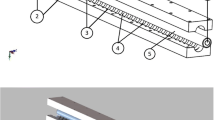Abstract
In this study, easy detection of Alicyclobacillus acidoterrestris was performed by determination of guaiacol in apple juice. Guaiacol produced by A. acidoterrestris was determined by using HPLC, UV-Vis spectrophotometer, and Minolta spectrophotometer. Statistical analysis showed that the methods used for measuring the guaiacol concentrations were not significantly different (p > 0.05). Guaiacol formation in apple juice spiked with different levels of A. acidoterrestris spores was also analyzed using Gompertz, Logistic, and Richards models. In all cases, a good agreement between experimental data and fitted values was obtained. Using the modified Gompertz model, the derived biological parameters were calculated. Guaiacol formation rates (μ) and final guaiacol concentrations (A) were very similar in all cases, regardless of the initial A. acidoterrestris spore counts. However, lag phase durations (λ) were found to be dependent on the initial bacterial counts, and increased from 28.4 to 37.6 h, when initial inoculation level decreased from ∼103 to ∼101 cfu/mL.



Similar content being viewed by others
References
Deinhard G, Blanz P, Parolla K, Altan E (1987) Syst Appl Microbiol 10:47–53
Wisotzkey JD, Jurtshuk P, Fox GE, Deinhard G, Poralla K (1992) Int J Syst Bacteriol 42:263–269
Lee SY, Dougherty RH, Kang DY (2002) Appl Environ Microbiol 68:4158–4161
Walker M, Phillips CA (2005) Int J Food Sci Technol 40:557–562
Yamazaki K, Teduka H, Shinano H (1996) Biosci Biotech Biochem 60:543–545
Borlinghaus A, Engel R (1997) Flüssiges Obst 64:306–309
Jensen N (2000) Food Aust 52:282–285
Jensen N, Whitfield FB (2003) Lett Appl Microbiol 36:9–14
Pettipher GL, Osmundson ME (2000) Food Aust 52:293–295
Chang SS, Kang DH (2004) Crit Rev Microbiol 30:55–74
Pettipher GL, Osmundson ME, Murphy JM (1997) Lett Appl Microbiol 24:185–189
Pinhatti MEMC, Variane S, Eguchi SY, Manfio GP (1997) Fruit Process 9:350–353
Bahceci KS, Gökmen V, Serpen A, Acar J (2003) Eur Food Res Technol 217:249–252
Splittstoesser DF, Lee CY, Churey JJ (1998) Dairy Food Environ Sanit 18:585–587
Walls I, Chuyate R (2000) J AOAC Int 83:1115–1120
Chang S, Kang DH (2005) J Appl Microbiol 99:1051–1060
Previdi MP, Colla F, Vicini E (1995) Industrial Conserve 70:128–132
Bahceci KS, Gökmen V, Acar J (2005) Fruit Process 5:328–331
Orr R, Beuchat LR (2000) J Food Protect 63:1117–1122
Niwa M, Kawamoto A (2003) Fruit Process 2:102–107
Bahceci KS, Gökmen V, Serpen A, Acar J (2005) Eur Food Res Technol 220:196–199
Silva FM, Gibbs P, Vieira MC, Silva CLM (1999) Int J Food Microbiol 51:95–103
Deinhard G, Blanz P, Parolla K, Altan E (1987) Syst Appl Microbiol 10:47–53
Silva FVM, Gibbs P, Silva CLM (2000) Fruit Process 4:138–141
Farrand SG, Linton JD, Stephenson RJ, MacCarthy WV (1983) Arch Microbiol 135:272–275
Cerrutti P, Alzamora SM, Vidales SL (1997) J Food Sci 62:608–610
Lopez-Malo A, Alzamora SM, Argaiz A (1998) J Food Sci 63:143–146
Fitzgerald DJ, Stratford M, Narbad A (2003) Int J Food Microbiol 2708:1–10
Bahceci KS, Serpen A, Gökmen V, Acar J (2005) J Food Eng 66:187–192
Zwietering MH, Jongenburger I, Rombouts FM, Van't Riet K (1990) Appl Environ Microbiol 56:1875–1881
Erkmen O, Alben E (2002) J Food Eng 52:161–166
Acknowledgments
Authors would like to thank Hacettepe University Scientific Researches Unit (Project no. 01.01.602.001) for financial support. They are also grateful to Yelda Zencir and Selin Heybeli for their help in performing the spectrophotometric analyses.
Author information
Authors and Affiliations
Corresponding author
Rights and permissions
About this article
Cite this article
Bahçeci, K.S., Acar, J. Determination of guaiacol produced by Alicyclobacillus acidoterrestris in apple juice by using HPLC and spectrophotometric methods, and mathematical modeling of guaiacol production. Eur Food Res Technol 225, 873–878 (2007). https://doi.org/10.1007/s00217-006-0495-6
Received:
Revised:
Accepted:
Published:
Issue Date:
DOI: https://doi.org/10.1007/s00217-006-0495-6




